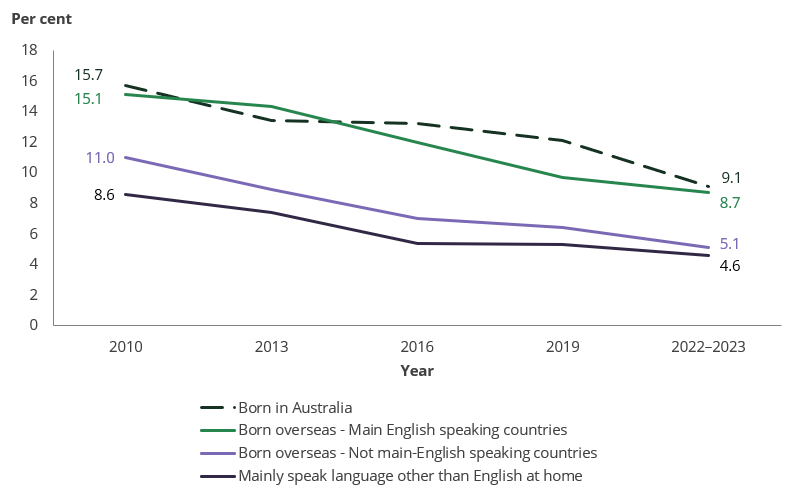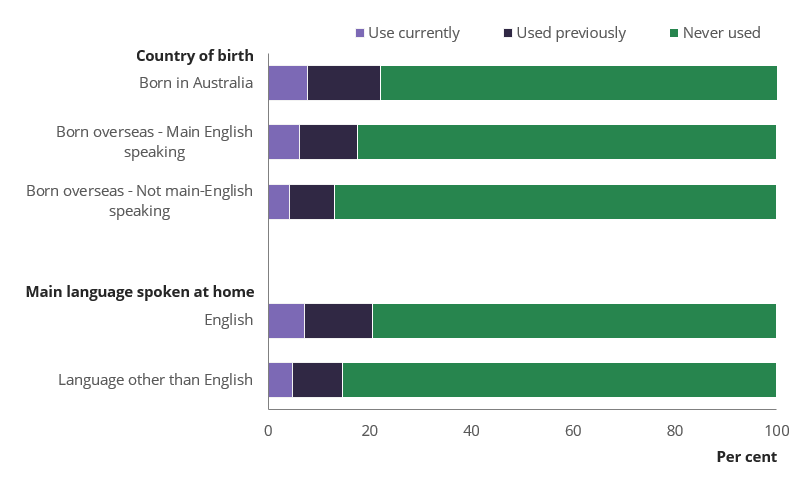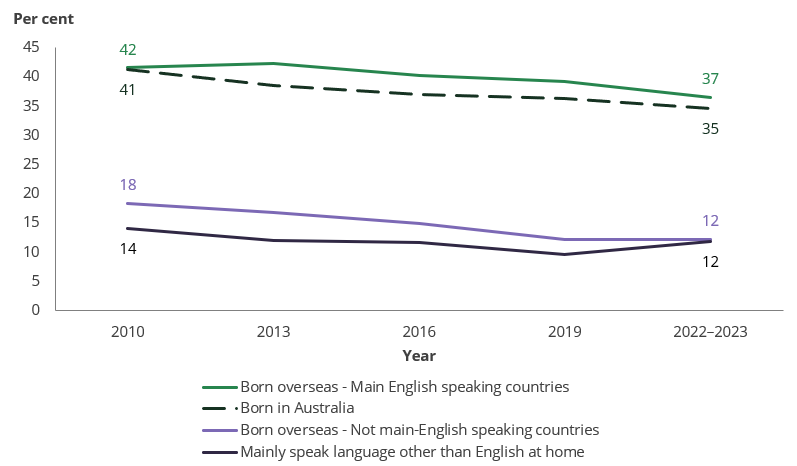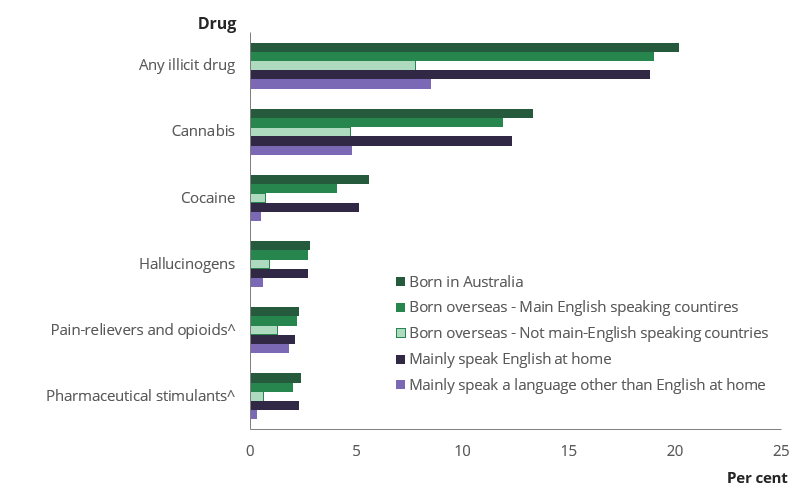Definition of CALD in the National Drug Strategy Household Survey
Some Culturally and Linguistically Diverse (CALD) populations have higher rates of, or are at higher risk of, alcohol, tobacco, and other drug problems (Department of Health and Aged Care 2017). The NDSHS uses questions from the Australian Bureau of Statistics (2022) Standards for Statistics on Cultural and Language Diversity, specifically three indicators:
- Country of birth. People could select from a list or write in the country in which they were born, and the following categories are used in reporting:
- Born in Australia
- Born overseas in main English-speaking countries (includes Canada, Republic of Ireland, New Zealand, South Africa, United Kingdom and United States of America).
- Born overseas in non‑main English-speaking countries. It is important to note that this does not imply a lack of proficiency in spoken English. - Main language other than English spoken at home.
- Proficiency in spoken English among people whose first spoken language was not English.
CALD groupings are broad and experiences with alcohol, tobacco and other drugs are likely to vary widely among people with different cultural and language backgrounds.
In this report, people with diverse backgrounds includes people with Culturally and Linguistically diverse backgrounds, as defined by the questions above.
It is important to note that while Aboriginal and Torres Strait Islander (First Nations) people are diverse in language and culture, their experiences are unique and are considered distinct from the experiences of CALD populations in Australia (AIHW 2023). Data on First Nations people can be found here.
Smoking lower among CALD populations since 2019
Despite small changes in daily smoking between 2019 and 2022–2023, a long-term decline in daily tobacco smoking occurred among all groups since 2010 (Figure 1).
Among people born overseas, declines in daily smoking were driven by an increase in the proportion of people who had never smoked:
- For people born in main English-speaking countries, the proportion who had never smoked increased from 48% in 2010 to 57% in 2022–2023.
- Over 3 in 4 (77%) people born in non‑main English-speaking countries had never smoked in 2022–2023, up from 71% in 2010.
The highest rates of daily smoking occurred among people born in New Zealand and Oceania excluding Australia (12.5%) and North Africa and the Middle East (11.0%).
The lowest level of daily smoking (4.6%) occurred among people who mainly spoke a language other than English at home, due to a relatively high proportion of people who had never smoked (82%) and who used to smoke but no longer do (11.3%).

Source: NDSHS 2022–2023, Table 10.9.
Use of e‑cigarettes and vapes increased between 2019 and 2022–2023
In 2022–2023, the proportion of people across Australia who had ever used an electronic cigarette/vape (‘e‑cigarettes’) increased substantially, as did the proportion currently using e‑cigarettes at the time of the survey. Culturally and Linguistically Diverse populations were no exception: 6.2% of people born overseas in main English-speaking countries currently used e‑cigarettes in 2022–2023 (more than double the proportion in 2019), and 4.3% of people born in non‑main English-speaking countries currently used them (more than triple the proportion in 2019) (Figure 2).
Current use of e‑cigarettes was highest among people born in New Zealand and Oceania excluding Australia, increasing from *2.7% in 2019 to 8.1% of people in 2022–2023.
* Estimate has a relative standard error between 25% and 50% and should be interpreted with caution.
People who mainly spoke a language other than English at home were 3.9 times as likely to currently use e‑cigarettes in 2022–2023 (4.7%) than in 2019 (1.2%).
Among people whose first language was not English, those who considered that they spoke English very well were much more likely to have tried e‑cigarettes (17.6%) than those who spoke English well (12.4%) or not well (9.2%).

Note: 'Use currently' includes people who reported using e‑cigarettes daily, weekly, monthly or less often than monthly. 'Used previously' includes 'I used to use them, but no longer use' and 'I only tried them once or twice'.
Source: NDSHS 2022–2023, Table 10.9.
People born in Australia were more likely to currently use e‑cigarettes than both people born overseas in main English-speaking countries (1.3 times as likely) and those born in non‑English speaking countries (1.8 times as likely). The same was true for people who mainly spoke English at home, who were 1.5 times as likely as people who mainly spoke other languages at home to use e‑cigarettes currently.
People with non‑English speaking backgrounds much less likely to drink alcohol at risky levels
As with almost all population groups, risky drinking was stable among Culturally and Linguistically Diverse population groups between 2019 and 2022–2023, although there has been a gradual decline among all population groups since 2010 (Figure 3).

Source: NDSHS 2022–2023, Table 10.9.
There was a large discrepancy in the proportions of people drinking alcohol at risky levels (Figure 3). This is primarily due to the proportion of people who had not consumed any alcohol in the previous 12 months:
- 43% of people born in non‑main English-speaking countries had not consumed alcohol in the previous 12 months, compared to 18.5% of people born in Australia.
- Half (51%) of people who spoke a language other than English at home had consumed no alcohol in the previous 12 months, compared to 19.1% of people who spoke English at home.
People born in the United Kingdom (39%) and New Zealand and Oceania excluding Australia (36%) were the most likely to have consumed alcohol at risky levels in 2022–2023. People born in the United Kingdom were much more likely to consume more than 10 standard drinks per week on average (35%) than people born in Australia (28%) or New Zealand and Oceania excluding Australia (27%).
People with diverse backgrounds much less likely to have used illicit drugs
There were very few changes in the use of illicit drugs between 2019 and 2022–2023 among Culturally and Linguistically Diverse populations. Differences that did occur were small, and generally reflected the total population aged 14 and over.

^ Used for non‑medical purposes in the previous 12 months.
Source: NDSHS 2022–2023, Table 10.9.
As shown in Figure 4, people with Culturally and Linguistically Diverse backgrounds were much less likely to have used illicit drugs in the previous 12 months than both people born in Australia or who mainly spoke English in 2022–2023. They followed similar patterns, and the largest differences in 2022–2023 were:
- People born in Australia were 2.6 times as likely as those born in non‑main English-speaking countries to have used any illicit drug (20% compared with 7.8%)
- Compared to people who mainly spoke another language at home, people who mainly spoke English were:
- 10.2 times as likely to have used cocaine (5.1% compared with 0.5%)
- 4.5 times as likely to have used hallucinogens (2.7% compared with *0.6%)
- Compared to people born in non‑main English-speaking countries, people born in Australia were:
- 2.8 times as likely to have used cannabis (13.3% compared with 4.7%)
- 1.8 times as likely to have used pain-relievers and opioids for non‑medical purposes (2.3% compared with 1.3%).
* Estimate has a relative standard error between 25% and 50% and should be interpreted with caution.
Again, while use of illicit drugs was lower among all people born overseas, some differences occurred by country of birth. For example, people born in North and South America were 1.1 times as likely as people born in Australia to have used an illicit drug in the previous 12 months. This was driven by a larger proportion of people who used hallucinogens (1.8 times as likely), ecstasy (1.4 times) and cannabis (1.3 times).
What does this tell us about the use of alcohol, tobacco and other drugs among people with Culturally and Linguistically Diverse backgrounds?
Overall, the 2022–2023 results tell a positive story for people who were born overseas or who mainly speak a language other than English at home. They were less likely to smoke tobacco, to drink alcohol in ways that put their health at risk, or to use illicit drugs than both people born in Australia and people who mainly spoke English at home.
It is important to note the categories used here are broad, and do not represent the diverse experiences of Culturally and Linguistically Diverse people living in Australia. Further exploration is required to fully understand the use of alcohol, tobacco, and other drugs among this population, which could include:
- Relationships between amount of time spent in Australia and use of alcohol and other drugs.
- Understanding how people with lower proficiency in spoken English access and use alcohol and other drug treatment services.


